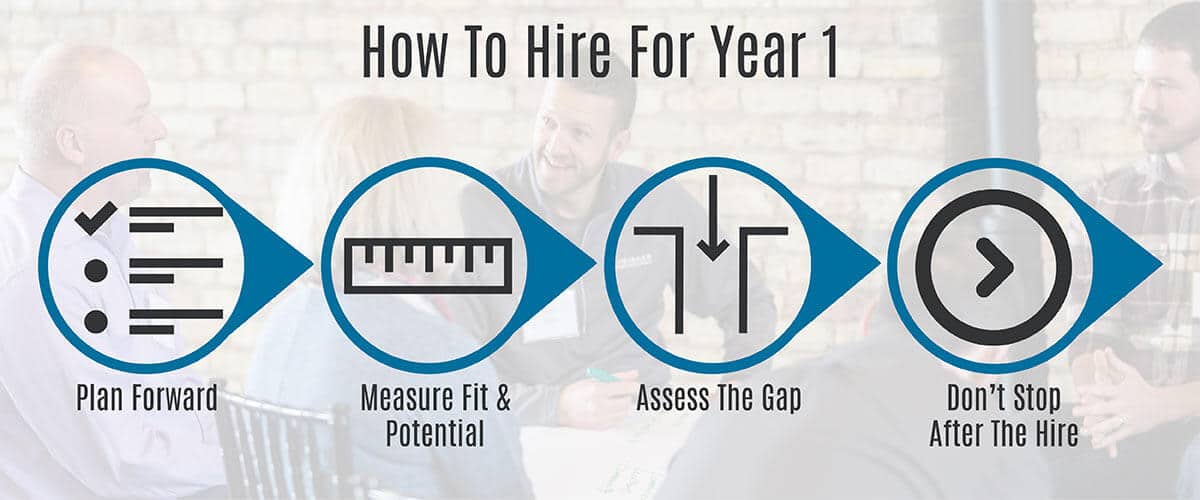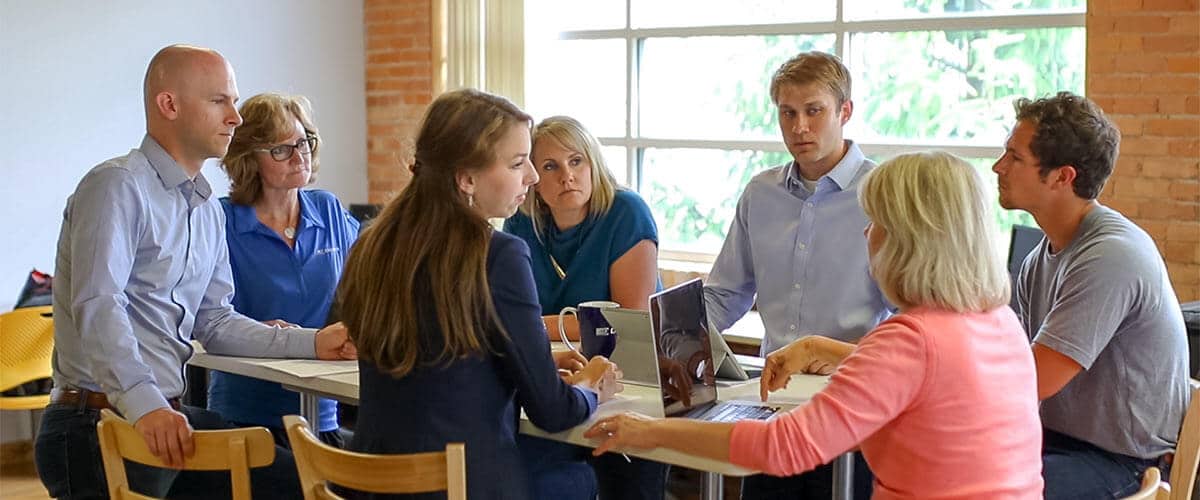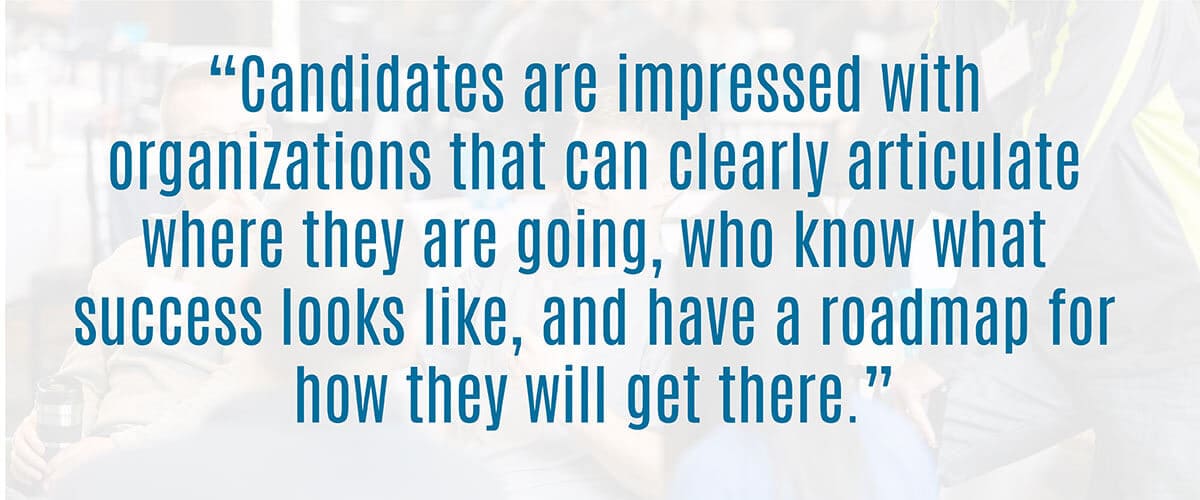Hiring for Year One (Part 2)
March 15, 2018


Written By:
Christy Landrigan | Team Lead - Talent Solutions
Kristian Woods | Team Lead - Talent Solutions

In part one of this series we described the need to shift the recruiting mindset from a hit-the-ground-running approach to a hiring-for-year-one strategy in order to better meet the challenges of today’s competitive hiring environment. In this entry, we will discuss how proactive recruiting and performance planning expands your talent pool and results in greater success. If you haven’t had the chance to read Hiring for Year One (Part 1), check it out.
1) Plan Forward
Recruiting has long been a reactive discipline. Pre-existing candidate qualifications are screened against pre-defined job descriptions until a hire is made. This is no longer the best method. Listing responsibilities is necessary to provide context and relative boundaries around job activities but stopping here is insufficient. Instead, companies need to plan and prepare better. Before they post a job, they should know what the role needs to accomplish over the next year. What are the priorities? What is expected from this person’s contributions? What needs to get done and why?
Planning at the outset of the recruiting phase is a critical step in connecting the purpose of a role with a company’s business performance. This connection provides two benefits:
1. Increased definition around what the role should accomplish, what success looks like, and how a new employee’s performance will be measured at their year-one evaluation will help organizations reach their goals.
2. Increased candidate engagement from a better understanding of the purpose of their role and how it will make an impact in the success of the business.
When companies have clarity around year one role deliverables and purpose, their ability to assess viable candidates is much more effective. Plus, they’ve increased their level of viability as a prospective employer from the candidate perspective.
2) Measure the Fit and Potential
It’s easy to fall into the trap of hiring candidates whose pre-existing skills check off the most boxes with the job description. In part one of this blog, we challenged this practice. Pre-existing experience is often necessary; however, when a Hiring Manager narrows their ideal candidate pool to such a limited extent, they’re essentially seeking somebody to make a lateral move.
With work evolving and the divide in the skills gap widening further yet, using one-sided, reactive methods is limiting. Companies should look at other ways to define what qualifies a candidate. First and foremost is the long-term cultural fit. What core values, behaviors, and attitudes do candidates need to possess regardless of their capabilities? Are there patterns of high performance and a strong work ethic? As for skills and experience, Hiring Managers should want gaps to exist. People perform their best when they are challenged and have the opportunity to grow.
3) Assess the Gaps
Intentionally work to identify gaps in candidates and capture them for planning purposes. When we’ve done our homework in determining year-one deliverables and what success looks like in a role, the purpose of the interview process is to identify candidates who will achieve success after a year, not on day one. Therefore, the interview becomes a gap assessment. How wide is the gap between a candidate’s present-day abilities versus the abilities needed to fulfill the year-one deliverables?
The purpose of identifying gaps is to weigh the extent and realities of the investment needed over the next year to support the person’s success. Organizations and candidates need to weigh the resources, time, and commitment required to fill in the gap. We recommend intentionally seeking candidates with a 20-30% gap (or stretch room) as a best practice.
The gaps captured during the recruiting phase will set the framework for a personal development plan should the candidate be hired. When companies intentionally seek out candidates with stretch room, they gain the immediate benefit of opening the candidate pool. The fewer the qualifications, the broader the pool. Additionally, candidate’s value the investment that companies make in increasing their abilities and, in turn, their loyalties and engagement strengthen. This leads us to the final stage of the hiring-for-year-one strategy.
4) Don’t Stop After the Hire
Providing candidates with year one objectives and purpose through the recruitment process provides them with unique clarity into the expectations and deliverables of the role. This also better positions the company in this competitive environment. Candidates are impressed with organizations that can clearly articulate where they are going, who know what success looks like, and have a roadmap for how they will get there. What happens after the hire is even more important. Post-hire onboarding, coaching, and communication activities are essential to supporting the new hire towards success for the next 365 days and thereafter.
The investment in the development and performance of candidates begins in the recruiting phase. Continuing this investment through intentional post-hire activities will increase the likelihood a new hire will fulfill company objectives and will cultivate a more engaged culture.
If you are overwhelmed with the process of hiring top talent or are experiencing rapid growth or high turnover, we would love to help you implement a similar strategy, tailor-made to your unique business needs. Contact the DISHER Talent Solutions team to get started.
Written By: Christy Landrigan with Kristian Woods, Team Leads – Talent Solutions
Christy has nearly a decade of recruiting experience, primarily for technical, professional and leadership positions within manufacturing. She advises and implements process improvements in recruiting teams for local and North American companies. Christy has a Bachelors Degree in Psychology and a Masters in Public Administration.
Kristian has a BA in HR Mgmt. from WMU. As a Talent Strategist, he helps organizations attract and retain top talent in a wide variety of industries and fields. He’s passionate about travel and experiencing new cultures which is why he joined the Peace Corps as a Small Business Development consultant where he served 27 months in Morocco.






